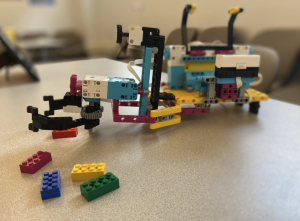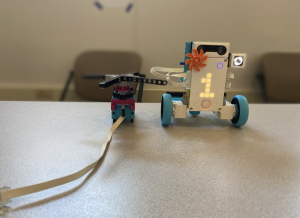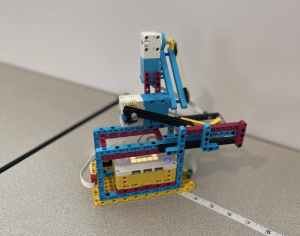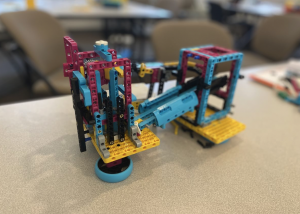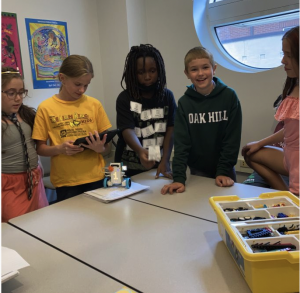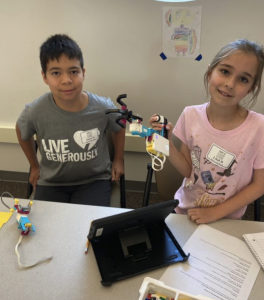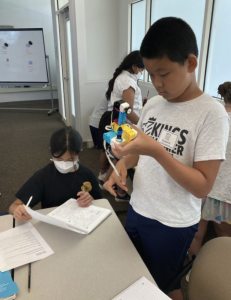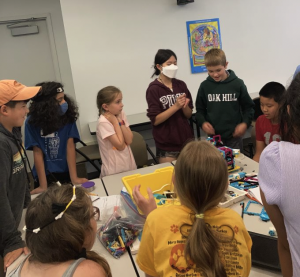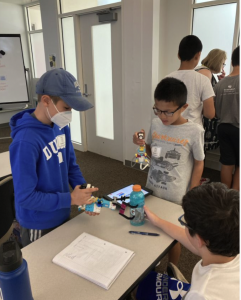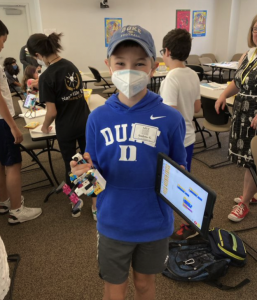Summer SAVY 2022/Session 3 – Robotic Engineering for Rising 5th/6th Grade
Friday: As a community we discussed time management as not only a group skill, but a life skill. We talked about ways to break up big projects and why having clearly defined roles and tasks is important, making sure there are checkpoints along the way, and when to ask for help. We also explored how to handle a project when everyone is interested in the same kind of work or, worse, there are tasks no one wants to complete. We talked about how compromise can help sort out the work and build consensus. These strategies were certainly put to the test today!
For our last day of camp, we had our “Invention Convention.” This was an opportunity for students to take everything they learned through the week and apply it to their prototype. Each company was challenged to plan, build, program, test, and iterate their prototype using the engineering design process. They were also asked to create a compelling sales presentation to pitch their inventions to potential “investors” (classmates).
What an impressive group of creations we had! But I would expect nothing less from this amazing group of creative thinkers. We had a Catapult 4000 machine, a truly GREAT Ball Contraption, a Fun Bot 2.0, a prosthetic device that helps colorblind children identify toys by color, a CNC machine crated to help preschool children who struggle with fine motor skills, and an ambitious Ping Pong Arcade game.
Ask your child to explain how they applied the engineering design process to create their final projects. How did they use their engineering notebooks throughout the week. (They brought it home today!) If they had time to make one more improvement to their final project, what would that have been? How did their team break up the work? In which areas did their team excel?
I hope our future leaders and innovators will take some of the tips and tricks learned this week and apply it to group work at school and beyond. It has been an absolute pleasure working with each of these students. Thank you for the privilege. Enjoy the rest of your summer!
Mrs. Penne
Thursday: This morning our creative inventors continued work on their prosthetics. Some companies took inspiration from previous projects and made improvements, while others experimented with free builds. Several created claw-style hands by applying knowledge from yesterday’s build, one company created a “LEGO destroyer” equipped with a robotic leg, and another created a pizza roller/slicer for their chef. It was interesting to learn how each team programmed their devices in different ways. During their presentations, colleagues were asked to share how they were able to break up the work, share their teamwork successes, and identify areas for improvement.
Tomorrow we will need to make some big decisions within our workgroups. Dealing with disappointment can be tough, even for adults, especially when our ideas are rejected. We discussed different ways of looking at the decision-making process and how we can frame our perspectives to lessen the disappointment.
As a community, we talked about what it means to be a lifelong learner and how one study from the NIH Institute on Aging showed video games showed potential in helping seniors improve aspects of their memory. Next, each company built a brain game “candy monster” and named it. The objective of this game was to feed a colorful candy array to the monster which would read the sequence. A second, random color array was then fed to the monster which had to communicate matches/mismatches.
How do programmers deal with complicated code? Today we learned how programmers use shortcuts to condense long or repetitive bits of code. In the LEGO Education App this is called a MyBlock. We learned about adding inputs and variables into our MyBlocks, as well. Tomorrow we will continue to explore this concept as we incorporate MyBlocks into our final projects.
LEGO conventions are held all over the world every year. One of the most popular attractions is the GBC or Great Ball Contraption. After a week of hard work, this afternoon we built a GBC of our own. We discussed how small-scale models are useful in the prototyping process. We would have liked more time to work on this project, but our days go by so quickly. Fortunately, we had one completed build and were able to see the GBC in action and understand how it works.
We’ve had so much fun this week – it’s hard to believe tomorrow is our last day. We will hold an in-class “Invention Convention.” Students will have an opportunity to revisit and improve upon a previous project or create an entirely new build. Each company will choose its project and follow the engineering design process to see it to fruition. At the end of the day, each company will give a sales pitch to “investors” (classmates.)
Thursday’s Fun Facts
- One team’s prosthetic arm was able to pick up the elusive Ice Breakers gum “ice cube!”
- We watched Swedish Folktronica band Wintergatan’s music machine video and many students are inspired to build their own machines. Check out their YouTube channel (wintergatan2000) for detailed videos about their design process.
Wednesday: We read some exciting news from the SAVY Business Journal (our classroom whiteboard) today. There were some staffing changes! Several colleagues “accepted” positions with a new company, and we even expanded SAVY Industries by forming a new joint venture! The purpose of this exercise was to expose each team to new colleagues and provide an opportunity to apply teamwork strategies to a new dynamic. As a class, we discussed ways to make new members feel valued, identify strengths, the importance of cross-training (making sure everyone has equal building and programming opportunities), and ways to ensure every voice on the team is heard. We also discussed being a good peer mentor.
Next, we reviewed the Engineering Design Process to provide our teams with a nine-step roadmap for our day’s activities. We also talked about using our engineering notebooks to help us document our iterations.
Can one size really fit all? Today we built a grabber device with a touch sensor trigger that included two variations: one for light, flexible objects and one for rigid, heavy objects. Each company designed its own criteria to evaluate the two devices, conducted experiments, and recorded data in their engineering notebooks. Then, it was time to take on the role of a design engineer. The objective: improve the design to create a more versatile grabber. Teams created parameters, brainstormed ideas, and made a decision. They sketched ideas in their notebooks before setting to work. There were many iterations as students worked to test and redesign their grabbers. Finally, we talked about making compelling sales pitches. Companies named their products and wrote and presented an infomercial to the class. We were entertained by some incredibly fun presentations!
Bioengineering is an exciting and growing field. We learned how college students are 3D printing mechanical hands for children with disabilities. Each company was invited to delve into this noble work by designing a prosthetic robotic hand. Campers were provided instructions for a base that wraps around the forearm, but the rest of the design will come from their imaginations! Teams were asked to create and help a fictional client with a disability. This challenging project provides a great opportunity to apply the engineering design process, teamwork strategies, prior knowledge, and creativity! We will continue to work on this build tomorrow.
Wednesday’s Fun Facts
- Many students in our class enjoy early-morning calisthenics, or so it seemed when we played our morning ice-breaker, “Apple, Orange, Banana.”
- We really, Really, REALLY like working sound blocks into our programs. Eight-bit music is especially popular.
- There was some amazing teamwork happening in our classroom today!
Tuesday: We started off our day with a fun game that required attention to detail and quick thinking. If there was an imaginary ball league, our team would be contenders! We quickly reviewed yesterday’s lessons before jumping into today’s activities.
We continued our group work discussion. Today we talked about the importance of organizing and delegating work to ensure everyone has a role. We talked about what makes a good team leader and the common mistakes leaders make. Finally, we talked about what to do when a team member isn’t paying attention or pulling their weight, strategies for working to engage them, and when it’s the right time to seek help from an adult.
Our first build of the day was a music and storytelling bot. Each company was asked to build a new toy using a color sensor that 1) plays music and 2) tells a story. Teams were asked to explore how rearranging, adding and subtracting bricks, adding gaps, and changing the speed and/or duration of a sound affected the melody. Next, workgroups were asked to tell a story using the sound effects provided in the app. Each company debuted its story bot with the other workgroups. This activity was popular and several of our campers wished they could have spent more time on this project.
Our colleagues had professional development today. Our wonderful TA, Ms. Sydney, spoke with the students about her first year as a mechanical engineering student at Duke, sharing several of the hands-on projects she and her classmates worked on. Then our campers explored different types of gears and their uses, gear trains, and learned how to change the direction of motion using bevel gears. We also talked about mechanical gain, learned how to calculate gear ratios, and how to achieve more torque or speed. Our engineers did a great job!
Using a basic driving base students learned how to set parameters (movement motors, movement speed, motor rotations), drive forward and backward, and how to form a square. We conducted experiments to compare turning with a gyro sensor and without, and students collected data to draw a conclusion. Teams then pseudocoded and programmed the robot to travel in a shape of their choice.
This afternoon we learned about Computerized Numerical Control or CNC machines. Our companies went into the business of refurbishing broken machines for resale. Teams had to identify the four mechanical problems of a build and fix them: a missing paper feeder wheel, correctly attaching the top to the base, switching the inverted feeder gears to slow the paper entering the machine, and reaffixing the pencil carriage. Once the problems were solved students tested the CNC machine by drawing a rectangle. Then they pseudocoded and programmed the machine to draw an image of their choice. We had some really creative original designs including a house, one drawn using different color pens, and one that came out with a 3D effect. We applied what we learned in professional development to calculate the gear ratio of the paper feeder and what that tells us about the design. Some of our teams took the build to the next level by adding touch sensors to start the machine and another was working to incorporate a color sensor when our day ended. This project was very popular and most of our class wanted more time.
Tuesday’s Fun Facts
- Dreams provide great storytelling material.
- Most of our campers would be interested in participating in a sleep study camp…at least that sounded like a good idea immediately after lunch.
- We had several amazing examples of peer mentorship in our class today!
Monday: Welcome to Robotics Engineering! It was such a pleasure meeting our talented community today. We are going to enjoy an amazing week together!
We started our day by getting to know one another through introductions. As a class, we established community rules we all agree to abide by. (Ex. “If a LEGO brick falls, immediately pick it up.”) Students then designed a personal crest and shared the significance of each element with the community. We learned we have many music fans, artists, and mathematicians!
Students are often assigned group projects but are seldom taught the strategies necessary for success. Today we talked about evaluating decisions and learned to rank them (minor, moderate, and significant). As a class, we evaluated real-world scenarios/decisions and ranked them, then talked about which merit discernment and which are best to decide quickly to keep projects moving. Rock-paper-scissors, anyone?
Our young professionals were grouped and asked to form a company and put these new decision-making strategies to work. Each start-up chose its company name, created a slogan, and designed a logo that incorporated at least one element from the founders’ personal crests. During their “grand opening,” each workgroup shared how they chose their name and what each founder contributed to the decision. Newly minted companies include Rainbow Robots, LEGO Creations Incorporated, Blurp, MMV (Mango Math Violin), and Iron Earth.
This week we will be using the LEGO Education App and LEGO SPIKE Prime robot kit for our hands-on activities. We completed a brief tutorial to become acquainted with the components: hub (“brain”); medium and large motors; touch/force, color, and ultrasonic sensors. We learned about the built-in gyro sensor and how pitch (y-axis), roll (x-axis), and yaw (z-axis).
Our first robot build of the day was a mechanical rhino for a “tech zoo” with a touch sensor. Students used estimation to evaluate distances and test findings, and deductive reasoning to improve their programs. We talked about repeatability and the importance of changing only one variable at a time. We used geometry to calculate wheel circumference, then predicted (using inductive reasoning) which method would be more accurate: rotations, specified distance, or travel time. They conducted experiments and recorded data to test their hypothesis.
Each company was tasked with a top-secret research and development project. Colleagues built a prototype of their new product and wrote assembly instructions. Instructions were passed to another team to test. Teams then presented their second builds and suggested improvements for their instructions. We learned that words alone can be confusing, but adding illustrations and color can be very beneficial. What did we learn from this exercise? Coding concepts: algorithm, bug, debug, decomposition, and pseudocode.
Our day passed very quickly! We talked briefly about our activities for the week and introduced tomorrow’s first project: a music and storytelling robot. Students will work together as a team to create a song and tell a story using sound effects. We wrapped up our day by journaling in our engineering notebooks just a few minutes before dismissal. We look forward to another busy day tomorrow!
Monday’s Fun Facts:The most wished-for superpower in our classroom is the ability to fly with invisibility and teleportation tied for second.
Students traveled from as far away as Stillwater, Oklahoma to join us this week!
Our class is evenly divided in its preference for sweet and salty snacks. We even had a few votes for spicy and savory!
